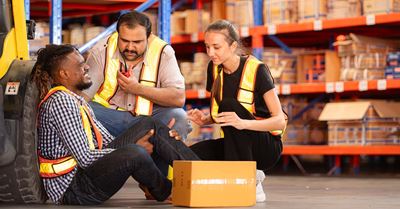How to Respond to a Forklift Accident in the Warehouse

Proper response to forklift incidents can minimize injury, reduce downtime, and ensure regulatory compliance.
Forklifts are perhaps the most important pieces of equipment in any given warehouse. Without them, the flow of products would simply stop. Despite their utility, forklifts can pose significant risks when not operated properly. Knowing how to respond effectively to a forklift accident can minimize injury, reduce downtime, and ensure compliance with safety regulations. The number one priority after a forklift accident is to ensure the safety of all personnel involved. Immediately stop the forklift and assess the situation. If the accident involves a person, check for any injuries. Do not move an injured person unless they are in immediate danger, such as from a fire or further collision. Call for medical assistance right away. While waiting for emergency responders, administer first aid if you are trained to do so. For example, if there is bleeding, apply pressure to the wound. Keep the injured person as calm and comfortable as possible, and avoid unnecessary movement. If the accident does not involve injuries but has caused property damage or poses other hazards (e.g., spilled materials), secure the area to prevent further incidents. Use cones, barriers, or warning signs to keep other workers away from the accident site. Once immediate safety concerns are addressed, the next step is to secure the scene. This involves making sure the accident area is safe from further hazards and preserving the scene for an investigation. Turn off the forklift, and if possible, do not move it from its position until a thorough inspection can be conducted. Take steps to ensure that any dangerous materials, such as leaking fluids or unstable loads, are contained and do not pose additional risks. If necessary, call in a qualified team to handle hazardous materials safely. It is crucial to document the scene as it is immediately after the accident. Take photographs or videos of the area, including the forklift, the load it was carrying, the condition of the floor, and any other relevant details. This documentation will be valuable for the subsequent investigation and any insurance claims. After securing the scene, the next step is to report the incident to your supervisor or the designated safety officer in the warehouse. This report should be made as soon as possible, providing them with all the relevant details about the accident, including the time, location, and the people involved. Depending on the severity of the accident, it may be necessary to notify external authorities, such as the Occupational Safety and Health Administration (OSHA). OSHA requires that certain types of accidents, particularly those involving fatalities or severe injuries, be reported within a specific timeframe. Your safety officer or supervisor should handle these communications. Additionally, the accident should be logged in the company’s incident report system, providing a detailed account of what happened. This report will be used in the investigation to determine the cause of the accident and to develop strategies to prevent similar incidents in the future. A thorough investigation is essential to understand the root cause of the forklift accident. The investigation should be led by a trained safety officer or an external expert if necessary. All relevant parties, including the forklift operator, witnesses, and anyone else involved, should be interviewed to gather as much information as possible. The investigation should consider a number of factors, including the condition of the forklift, the operator's training and experience, the environment in which the accident occurred, and whether safety protocols were followed. The goal is not only to identify what went wrong but also to understand why it happened. Once the investigation is complete, the findings should be reviewed with all warehouse staff. This review is an opportunity to reinforce safety practices and to implement any new measures that could prevent future accidents. These measures might include additional training for operators, changes to warehouse layout, or upgrades to equipment. After the accident and investigation, it is important to provide support for the employees involved. This support may include medical care, counseling, or time off work to recover. Ensuring that employees feel supported can help them recover more quickly and reduce the impact on workplace morale. Finally, review and update your warehouse’s safety procedures based on the lessons learned from the accident. Regular safety audits, refresher training, and open communication about safety issues can help maintain a safe working environment and reduce the likelihood of future forklift accidents.Immediate Response: Ensure Safety and Provide First Aid
Secure the Scene: Preserve Evidence and Ensure Safety
Report the Incident: Notify Supervisors and Authorities
Investigation: Determine the Cause and Prevent Future Accidents
Follow-Up: Support for Affected Employees and Review of Safety Procedures

